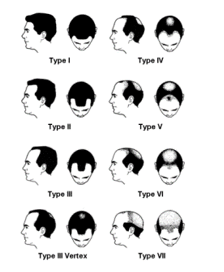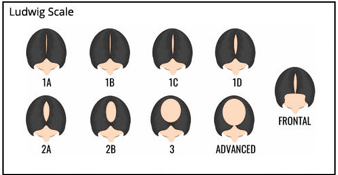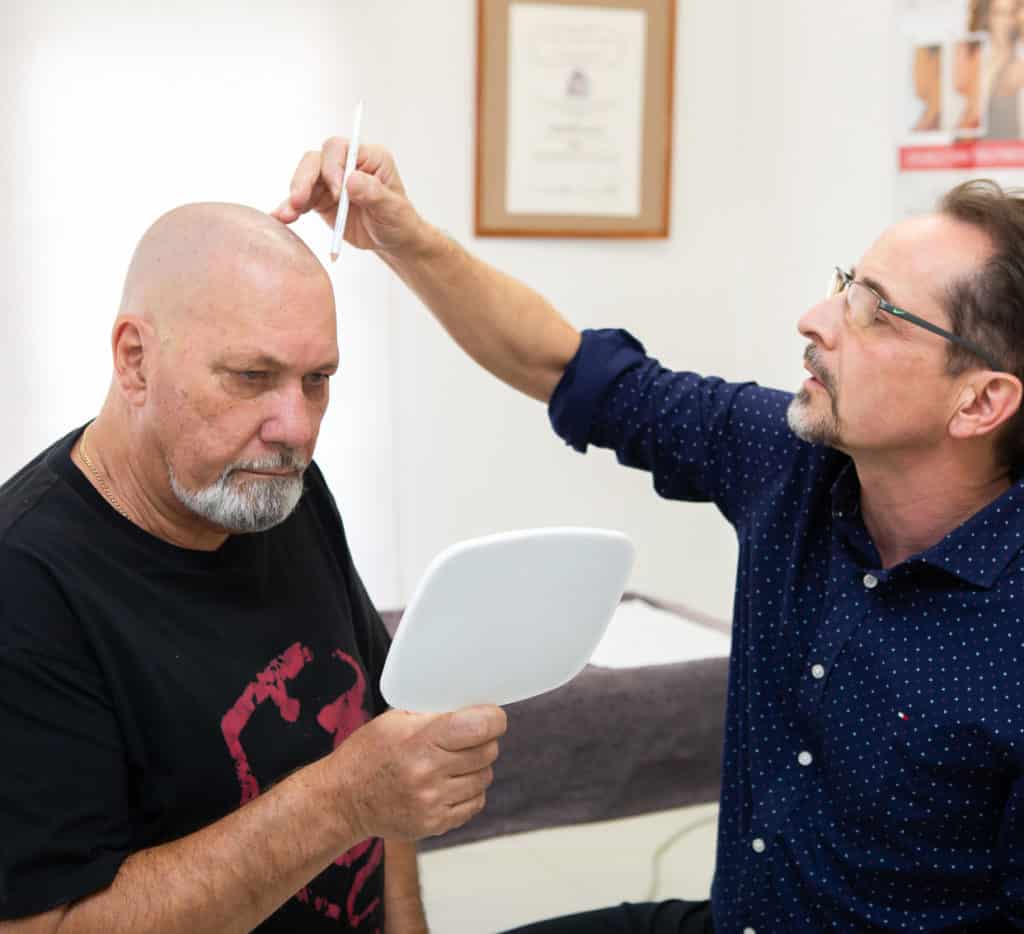The Three Best options For Hair Loss for Men and Women
This article is discussing male and female pattern hair loss – by far the most common types.
Male pattern hair loss causes a receding hairline and often thinning or balding at the crown. Importantly it can start as early as the late teenage years and early treatment is imperative. Female pattern hair loss is also very common – affecting around 30-40% of women – it has a different pattern causing thinning of the hair at the front of the head but not a receding hairline as much.
It generally starts later in life.
Male and female pattern hair loss stages


There are many other causes of alopecia (hair loss), although they are less common. If you have patchy loss of hair, very sudden hair loss, or if the scalp looks waxy or pale, or red or inflamed, there is probably some other cause and you should certainly get an appointment with a doctor (or here at Envisage Clinic) for diagnosis and treatment.
The bad news is that both male and female pattern hair loss are lifelong conditions that worsen over time if untreated. Hair only grows at 1cm per month, so be aware that any treatment that you use will take months to show a result, and you will have to continue its use for many months or years.
There are also many phony or unsubstantiated products marketed, especially on the internet and social media, that have little to no benefit.
The good news is that we do have treatments for male and female hair loss that work very well and are safe to use.
As the hair loss process progresses it takes time for the number of hairs to diminish. Initially hairs start to grow for a shorter time span and become shorter and finer – a process called miniturisation.
Diagram illustrating progressive miniturisation and hair loss

Non-surgical treatments for hair loss aim to stop and reverse this miniturisation process. This is why it is important to start treatment before the condition is too advanced. In some situations this will mean starting treatment in the late teenage years or early 20’s for males.
So what are the best options for hair loss
- Minoxidil. Minoxidil is available as a topical or oral treatment. Topical Minoxidil is available over
the counter, without a script, at chemists in Australia. It can be very effective, but most people
find that using it regularly for many months or longer becomes a nuisance and difficult to
maintain. Oral minoxidil is available as a prescription medication. In my experience it is far
superior as far as results go and is inexpensive with almost no side effects. It does not affect
hormone levels. It is also very easy and quick to use. - Regenera Activa. Regenera Activa is a stem cell type treatment. Treatment is drug free (apart
from a small amount of local anaesthetic), quick (30-45 minutes) and with minimal discomfort
and zero down time. During treatment 3-4 tiny samples of hair follicles are taken from the back
of the head. No stitches are needed. These small biopsies are disaggregated in saline solution
which produces a suspension that is very rich in hair follicle progenitor cells – similar to stem
cells. This solution is micro-injected through the affected scalp. Studies show an average of 30%
increase in hair growth in treated areas and results are quite long lasting – only a single
treatment is needed, possibly with top up treatments every 2 years or so. - FUE Hair Transplant If hair loss is too advanced for the above options, a hair transplant may be
needed. Modern hair transplants are effective and produce lifelong results. In simple terms
individual hair roots (follicles) are extracted from the back of the head (an area never affected
by male or female pattern hair loss) and planted individually in the balding areas. Hair
transplants can be used to recreate and fill a receding hairline or fill in a bare spot on the crown
of the head. They are performed under local anaesthetic only and should give very natural,
undetectable results.
What are the other options for hair loss? - Platelet Rich plasma (PRP). Envisage clinic no longer offers PRP as a treatment for hair loss.
Compared to Regenera Activa treatments are much more painful, need to be repeated
multiple times, and in our experience it simply does not give the results that we achieve
with Regenera Activa. - Finasteride (Propecia) and Dutesteride. These are prescription only medications that act by
reducing DHT Testosterone levels. They can work quite well, although we feel that Minoxidil
is superior, but in some men can cause libido issues and mood disturbance (depression). We
do not prescribe them on a regular basis because of this. - Laser caps and LED light therapy. There is some evidence that these can work, although
probably only to a small degree. The problem is that they have to be used almost daily and
for months at a time. LED caps are available online but are expensive ($2,000-$3,000). - Herbal treatment. Some herbs are probably beneficial for hair loss. Topical rosemary oil has
one study supporting its use, but would be time consuming and messy to use on a daily
basis. Some herbs like Saw Palmento also have some evidence supporting their use, but
probably do not work well enough for most people to be a standalone solution. - Exosomes and Growth factors. These are new options for hair loss. Most are administered
with fine dermal needling. They do need a series of treatments. At Envisage Clinic we are
trialling the best options in this field at the moment.
Article by Dr Christopher Leat – Medical Director Envisage Clinic Benowa

Dr Christopher Leat – Medical Director Envisage Skin Clinic Founder and Director.
Dr Christopher Leat has 33 years’ experience in Medicine and is a member of The Royal College of Physicians of London.
Dr Leat has devoted the last 18 years to Cosmetic Medicine and is recognized throughout Australia as one of the most experienced doctors in the field of Cosmetic Medicine.

